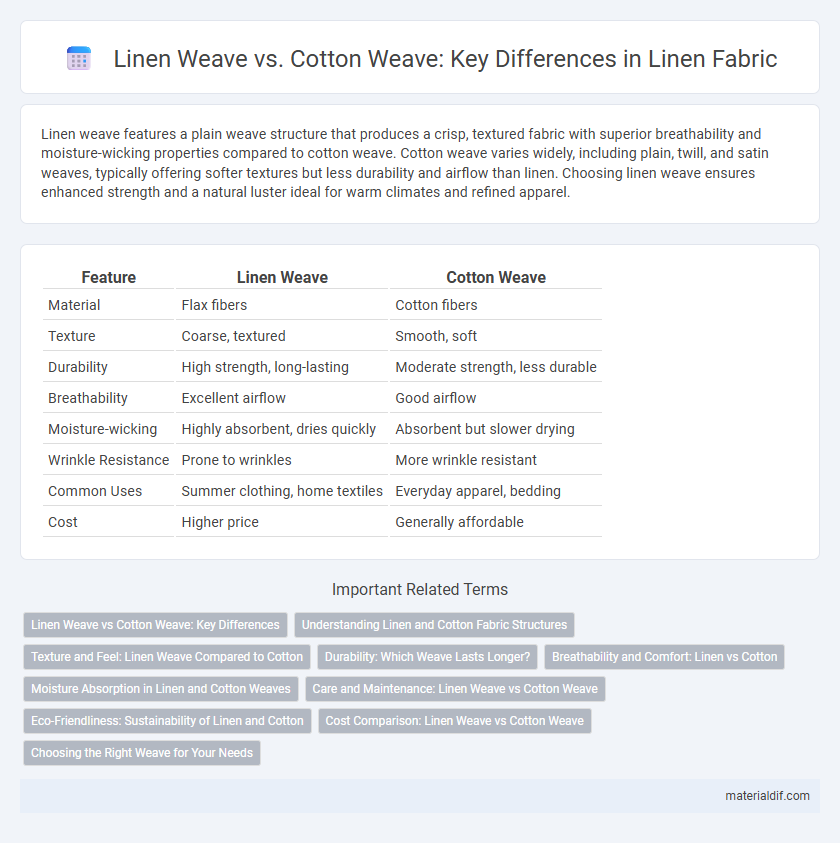Linen weave features a plain weave structure that produces a crisp, textured fabric with superior breathability and moisture-wicking properties compared to cotton weave. Cotton weave varies widely, including plain, twill, and satin weaves, typically offering softer textures but less durability and airflow than linen. Choosing linen weave ensures enhanced strength and a natural luster ideal for warm climates and refined apparel.
Table of Comparison
| Feature | Linen Weave | Cotton Weave |
|---|---|---|
| Material | Flax fibers | Cotton fibers |
| Texture | Coarse, textured | Smooth, soft |
| Durability | High strength, long-lasting | Moderate strength, less durable |
| Breathability | Excellent airflow | Good airflow |
| Moisture-wicking | Highly absorbent, dries quickly | Absorbent but slower drying |
| Wrinkle Resistance | Prone to wrinkles | More wrinkle resistant |
| Common Uses | Summer clothing, home textiles | Everyday apparel, bedding |
| Cost | Higher price | Generally affordable |
Linen Weave vs Cotton Weave: Key Differences
Linen weave features a distinct plain weave structure with thicker, more tightly twisted fibers derived from flax plants, resulting in a durable and breathable fabric ideal for warm climates. Cotton weave typically uses softer, finer fibers and exhibits various weave patterns such as plain, twill, or sateen, offering a smoother texture with greater elasticity compared to linen. The inherent moisture-wicking property and natural luster of linen weave differentiate it from the softer, more flexible cotton weave, making linen preferable for textured, breathable textiles.
Understanding Linen and Cotton Fabric Structures
Linen weave features a plain weave with thicker, uneven fibers derived from flax plants, providing natural breathability and moisture-wicking properties ideal for warm climates. Cotton weave typically involves tightly woven, uniform threads that create a smoother, softer fabric with higher elasticity and durability suitable for everyday wear. The structural difference in fiber composition and thread density between linen and cotton weaves directly impacts texture, strength, and fabric performance.
Texture and Feel: Linen Weave Compared to Cotton
Linen weave offers a unique texture characterized by its natural slubs and slightly coarse surface, providing a crisp and breathable feel ideal for warm climates. Cotton weave typically delivers a smoother, softer texture with a more consistent and plush finish, enhancing comfort for everyday wear. The distinct hand-feel of linen is often described as firmer and more textured compared to the gentle, supple softness of cotton fabrics.
Durability: Which Weave Lasts Longer?
Linen weave is known for its exceptional durability due to the strong flax fibers and the loosely woven structure that allows for better breathability and resistance to wear. Cotton weave, while softer initially, tends to wear out faster because its shorter fibers and denser weave are more prone to pilling and thinning over time. When comparing durability, linen weave consistently outlasts cotton weave, making it a superior choice for long-lasting textiles.
Breathability and Comfort: Linen vs Cotton
Linen weave offers superior breathability compared to cotton weave due to its loosely twisted fibers and natural moisture-wicking properties, making it ideal for hot and humid climates. Cotton weave, while soft and comfortable, tends to retain more heat and moisture, which can reduce overall comfort in warm conditions. The open structure of linen weave enhances airflow and cooling, providing a fresher feel against the skin than the denser cotton weave.
Moisture Absorption in Linen and Cotton Weaves
Linen weave outperforms cotton weave in moisture absorption due to its natural fiber structure, which allows it to wick moisture away from the skin more efficiently. The flax fibers in linen have superior breathability and quick-drying properties compared to cotton's denser cellulose fibers. As a result, linen fabrics provide better comfort in humid conditions by reducing sweat retention and enhancing airflow.
Care and Maintenance: Linen Weave vs Cotton Weave
Linen weave requires more delicate care due to its natural fibers, often benefiting from gentle washing and air drying to prevent shrinking and maintain texture. Cotton weave is generally more durable and easier to maintain, tolerating machine washing and higher heat drying without significant wear. Both fabrics benefit from avoiding harsh detergents, but linen's propensity to wrinkle and fray demands more attentive handling for longevity.
Eco-Friendliness: Sustainability of Linen and Cotton
Linen weave is derived from flax fibers, making it highly sustainable due to flax's low water and pesticide requirements compared to cotton. Cotton weave, although popular, often relies on intensive water use and chemical treatments, raising environmental concerns. The durability and biodegradability of linen contribute to its superior eco-friendliness in textile production.
Cost Comparison: Linen Weave vs Cotton Weave
Linen weave typically incurs a higher cost compared to cotton weave due to the labor-intensive production process and the durability of flax fibers. Cotton weave is generally more affordable as cotton is widely available and easier to process, resulting in lower manufacturing expenses. The price difference reflects linen's premium quality and longer lifespan, making it a more expensive but durable textile choice.
Choosing the Right Weave for Your Needs
Linen weave offers superior breathability and durability due to its thicker, textured fibers, making it ideal for warm climates and long-lasting textiles. Cotton weave provides a softer, smoother finish with greater elasticity, perfect for everyday comfort and easy maintenance. Selecting the right weave depends on your preference for texture and use, with linen excelling in crispness and cotton in flexibility.
Linen Weave vs Cotton Weave Infographic

 materialdif.com
materialdif.com